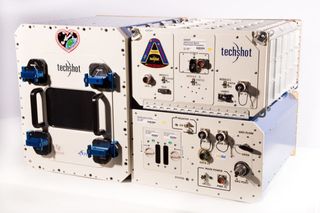A BFF in Space! Bioprinter Will 3D-Print Human Tissue on the Space Station
The futuristic gizmo will launch this month.

A new 3D printer aims to create human tissue in space after it launches to the International Space Station aboard a SpaceX cargo mission this month.
The printer, formally called the 3D BioFabrication Facility (BFF), aims to use adult human cells and adult tissue-derived proteins (or chains of amino acids) as source material for viable tissue. It's a first small step to eventually creating human organs — such as hearts or lungs — using 3D printers, spaceflight equipment operator Techshot said in a statement.
"The initial phase for BFF, which could last about two years, will involve creating test prints of cardiac-like tissue of increasing thickness," said Techshot, which is collaborating on the project with nScrypt, a 3D bioprinter and electronic printer manufacturer.
Related: 3D Printing: 10 Ways It Could Transform Space Travel
Techshot added that the next planned phase of BFF would last through about 2024. This would involve manufacturing heart patches in space, then evaluating their performance on Earth in small animals, such as rats.
"Ultimately, long-term success of BFF could lead to reducing the current shortage of donor organs and eliminate the requirement that someone must first die in order for another person to receive a new heart, other organ or tissue," Techshot said.
While creating human tissue in space is an expensive proposition, there are advantages to doing the work in microgravity instead of under Earth's gravitational pull. Tissues made on Earth tend to collapse under their own weight, Techshot said, "resulting in little more than a puddle."
Get the Space.com Newsletter
Breaking space news, the latest updates on rocket launches, skywatching events and more!
In microgravity, however, the 3D-printed structures will remain stable and strong, according to the company. These space-printed tissues could then be placed in a cell-culturing system to get stronger and withstand the pull of Earth's gravity.
The CEO of nScrypt, Ken Church, has a personal desire to see BFF succeed, because his daughter was born 24 years ago with a single lung. While she remains healthy and active today, Church said in the Techshot statement, he remembers wishing doctors could make her a second lung.
"Assembling a human lung or other organ is still years away, but it is no longer science fiction," Church said. "BFF is the roadmap for getting there, and this BFF team knows how to follow that map. I have no doubt someday BFF will provide someone like my daughter with a second lung."
- Making Stuff in Space: Off-Earth Manufacturing Is Just Getting Started
- Space Station's Commercial 3D Printer Makes Its 1st Tool (Photos)
- How 3D Printing Will 'Rock the World' — and Space
Follow Elizabeth Howell on Twitter @howellspace. Follow us on Twitter @Spacedotcom and on Facebook.
Join our Space Forums to keep talking space on the latest missions, night sky and more! And if you have a news tip, correction or comment, let us know at: community@space.com.

Elizabeth Howell (she/her), Ph.D., is a staff writer in the spaceflight channel since 2022 covering diversity, education and gaming as well. She was contributing writer for Space.com for 10 years before joining full-time. Elizabeth's reporting includes multiple exclusives with the White House and Office of the Vice-President of the United States, an exclusive conversation with aspiring space tourist (and NSYNC bassist) Lance Bass, speaking several times with the International Space Station, witnessing five human spaceflight launches on two continents, flying parabolic, working inside a spacesuit, and participating in a simulated Mars mission. Her latest book, "Why Am I Taller?", is co-written with astronaut Dave Williams. Elizabeth holds a Ph.D. and M.Sc. in Space Studies from the University of North Dakota, a Bachelor of Journalism from Canada's Carleton University and a Bachelor of History from Canada's Athabasca University. Elizabeth is also a post-secondary instructor in communications and science at several institutions since 2015; her experience includes developing and teaching an astronomy course at Canada's Algonquin College (with Indigenous content as well) to more than 1,000 students since 2020. Elizabeth first got interested in space after watching the movie Apollo 13 in 1996, and still wants to be an astronaut someday. Mastodon: https://qoto.org/@howellspace